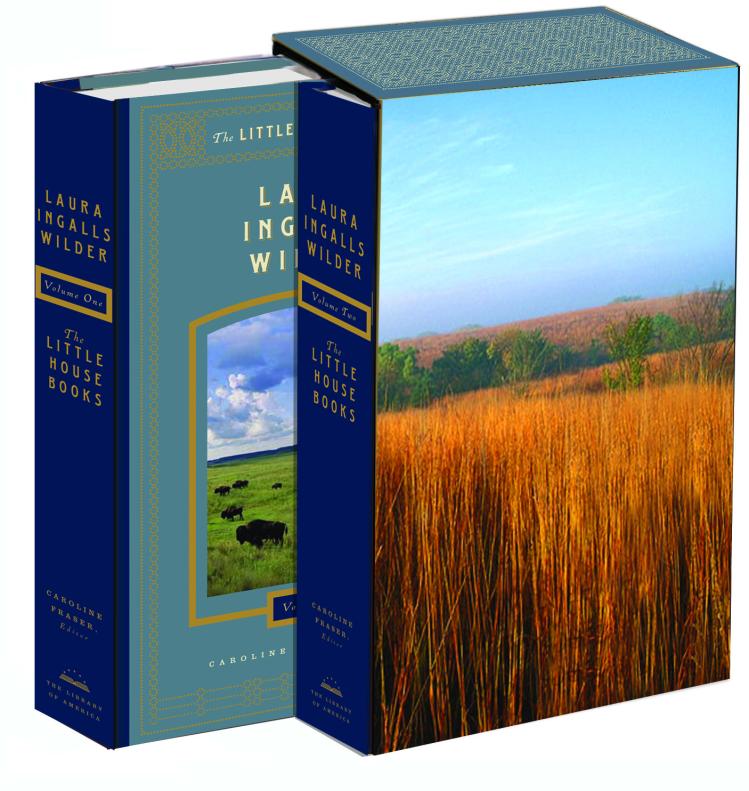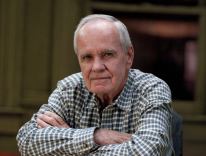
Laura Ingalls Wilder was “past sixty,” as she put it, when she began writing her “Little House books,” which chronicle the adventures of the Ingalls family, her family, as late-nineteenth-century American pioneers. Those sixty years had seen such dramatic changes in American life and in the country’s landscape that the stories of young Laura Ingalls seemed like dispatches from another world. In a letter distributed by her publisher, Wilder assured readers, “I lived everything that happened in my books.”
Wilder’s eight books, published in the 1930s and ’40s, made her a literary celebrity in her old age. She spent her final years attending dedication ceremonies for libraries named in her honor. Generations of children have been brought up on her stories. Now, a new two-volume edition of the Little House books from the Library of America stakes a claim for Wilder’s work as an enduring part of the country’s literary heritage—not just a journal of a frontier girlhood meant to amuse children, but skillfully crafted literature. The Little House books are a valuable eye-witness account of a fascinating and fleeting time in America’s history. They are also first-rate fiction, with gripping drama and finely drawn characters—particularly the author’s alter ego, Laura Ingalls, who thrives on the edge of civilization and is ambivalent about settling down into adulthood. Wilder’s straightforward, plainspoken style, with its occasional bursts of lyricism, has aged well—though she is speaking about the past, she seldom seems to be speaking from the past. If her novels “capture the best of the American pioneer spirit,” as the jackets of my 1970s Harper Trophy paperbacks declare, they also capture the best qualities of American writing in the twentieth century.
The first book in the series, Little House in the Big Woods, was published in 1932, and its success led Wilder (who was born in 1867) to undertake what she described as “a seven-volume historical novel for children concerning every aspect of the American frontier.” (There were ultimately eight installments, including Farmer Boy, which recounts the childhood of Wilder’s husband, Almanzo, in New York state.) The result was a beguiling combination of memoir, fiction, and history lesson. The story of the settlement of America’s frontier was also the story of its disappearance, and by the time she started writing, Wilder found that the ordinary details of her childhood had become “stories of long ago” that attracted young people’s imaginations just as her own father’s stories had once delighted her. Her unique achievement in the Little House books is portraying a particular historical context in minute detail—Big Woods alone could double as a wilderness survival manual, with its thorough descriptions of bullet-making and venison-smoking—while also painting a warm and convincing portrait of family life that, eighty years on, still feels authentic. Announcing that she had “lived everything” she wrote was Wilder’s canny way of telling readers what they wanted to hear—You can trust me; it was real—without actually saying It’s all true.
Readers revisiting the series as adults—especially those whose memories were muddied by the melodramatic 1970s and ’80s television series Little House on the Prairie—may be surprised by Wilder’s sure hand as a writer, and by the emotional impact of her heroine’s coming of age. And anyone who has wondered just how much of what Wilder wrote is “true”—and what happened to her characters in “real life” after the Little House books came to a close—will find the new Library of America edition a welcome resource. The novels are printed in full across two volumes (without the illustrations found in children’s editions), along with some other documents—like the letter to readers mentioned above—and a chronology of Wilder’s life, as well as explanatory notes on the text. Editor Caroline Fraser’s endnotes call out harmless anachronisms (like Pa playing a popular song on his fiddle that hadn’t yet been composed) as well as more significant departures from the historical record (like Wilder revising her husband’s age down to narrow the real-life ten-year gap between them). They are particularly helpful when it comes to sorting out the historical background to the Ingallses’ adventures—for example, the confusion about treaty terms that causes the family to settle briefly in “Indian Territory” and then reluctantly move on in Little House on the Prairie. For a parent or teacher seeking more historical context to flesh out Laura’s limited perspective on Native Americans and their conflicts with white settlers, Fraser’s notes are an excellent guide.
Wilder’s books are now historical documents twice over; today we are further removed from the time in which she wrote them than she was from the era she wrote about. The series’ focus on self-reliance and hard work must have seemed a natural theme during the Great Depression. (Losses from the 1929 crash motivated Wilder to try her hand at writing fiction in the first place.) The books written during World War II are self-consciously patriotic—a Fourth of July celebration in Little Town on the Prairie, published in 1941, drags uncharacteristically thanks to a too-long quotation from the Declaration of Independence. But none of that interferes with the series’ accessibility or appeal today. The character of Laura, who celebrates her fifth birthday during Big Woods and marries, at eighteen, at the end of These Happy Golden Years, is vividly drawn, especially in her early years. Wilder has the rare gift of inhabiting a child’s perspective with no irony or condescension, making little Laura’s thoughts and experiences relatable and compelling even for adult readers. Rereading On the Banks of Plum Creek, my cheeks still burned with indignation when a heedless neighbor child mistreated Laura’s beloved rag doll, Charlotte, and when the Ingalls sisters were taunted as “country girls” by snobby Nellie Oleson (surely one of American fiction’s most indelible villains). Laura’s fraught relationship with her older, annoyingly “good” sister Mary—for years her only playmate, as well as her most intense rival—is as compelling an account of the sibling bond as I have read. Wilder makes the frustration of always being a step behind so palpable I felt I ought to send flowers to my own slightly-younger sister by the time I finished rereading Big Woods. And it is impossible not to sympathize with Laura’s struggles to master the high degree of self-control expected of children in her day.
“Running through all the stories, like a golden thread,” Wilder remarked, “is the same thought of the values of life. They were courage, self-reliance, independence, integrity, and helpfulness. Cheerfulness and humor were handmaids to courage.” The Little House books would have far less appeal if that “golden thread” appeared as outright preaching. But Wilder never slips into a scolding “in my day…” tone. Nostalgia for its own sake is scorned—“Other folks can stick to old-fashioned ways if they want to,” Pa announces in Big Woods, “but I’m all for progress”—and sentimentality is very seldom indulged. When an emotion needs expressing, Wilder turns to Pa and his fiddle. The books are thus a scrapbook of nineteenth-century American popular song, and many a chapter fades out to a perfectly chosen hymn or ballad. (Others, like the song about “old Uncle Ned” who is “gone where the good darkeys go,” are less edifying.)
To reread the Little House books as an adult is to approach them with a double consciousness, persuaded by Laura’s perspective but also sensitive to the adult concerns at the edge of her awareness. The details she drops in about her parents—Ma, who “hated Indians” and “had been very fashionable, before she married Pa,” and Pa, who loves the wilderness and only reluctantly submits to his wife’s desire for a stable and “civilized” home—hint at complex interior lives. I am touched, as Wilder must have been in retrospect, by Ma’s small vanities, her attempts to bring a bit of elegance to her rustic surroundings—most memorably the cherished china shepherdess, displayed on a specially carved shelf, that makes each new house feel like a home.
The family’s circumstances are nearly always precarious, yet little Laura’s sense of security is unwavering. While her parents struggle, in some cases literally, to keep the wolf from the door, she is untroubled: “She was glad that the cozy house, and Pa and Ma and the firelight and the music, were now,” Wilder writes in the elegiac final passage of Big Woods. “They could not be forgotten, she thought, because now is now. It can never be a long time ago.” Laura’s confidence that life will go on the way it always has brings a sweetly poignant note to a series built on the awareness—and eventually, the experience—of rapid, unavoidable change. The next book (after Farmer Boy), Little House on the Prairie, finds the Ingallses leaving that cozy home for good and setting out for new territory. Laura begins to develop a sense of the world around her as something less than dependable. Later books offer sustained encounters with danger and deprivation: flash prairie fires, a horrifying locust infestation, a punishing series of blizzards in The Long Winter. Each time, the family’s resilience is tested more directly. And throughout the series, the adults respond to even major setbacks with a stoicism so deadpan it’s comical: “All’s well that ends well,” Ma will say when someone narrowly escapes death, or “Least said, soonest mended.” When a swarm of blackbirds destroys the family’s crops, Ma serves blackbird pie for dinner, noting, “There’s no great loss without some small gain.”
Notes left behind by the author and her daughter, Rose Wilder Lane, who edited the manuscripts, reveal a struggle over this aspect of Wilder’s style. Lane wanted more emotionalism, but Wilder defended her restraint—“this feeling that you call apathy and I call stoicism”—as an accurate reflection of the characters and the time. “It seems to me we were rather inclined to be fatalistic—to just take things as they came,” she wrote. “I know we all hated a fuss, as I still do.” (Viewers of the TV series know that Michael Landon came down on Rose’s side.) Concerned about making the books “too sad” for children, Wilder wrote sparingly but honestly of the emotional burdens of hard weather, illness, and loss. Lane did convince her mother to begin By the Shores of Silver Lake with an account of the family’s recent troubles, including the scarlet fever epidemic that had left Mary Ingalls blind: “Her blue eyes were still beautiful, but they did not know what was before them, and Mary herself could never look through them again to tell Laura what she was thinking without saying a word.”
I remembered the books as a collection of entertaining stories, but reading them again I marveled at Wilder’s careful handling of suspense and foreshadowing, and the way she shapes nearly every book in the series around a warm Christmas gathering. Her subtle command of pattern and variation holds the series together. The books also build on each other, with occasional references to incidents and characters from earlier in the series. (The scene involving Laura’s ruined doll has deeper resonance for the reader who already knows that “Charlotte had been Laura’s own since Christmas morning long ago in the Big Woods of Wisconsin.”) Over the long arc of the series, Wilder’s skill as a fiction writer becomes clear—it is a stroke of genius, for example, to bring the hissable Nellie Oleson (a composite of real-life classmates of Wilder’s) back into Laura’s life as a teen in Little Town on the Prairie, where social conflicts replace the existential crises of earlier books.
After years of moving from one home to another, the Ingallses settle in the “little town” in South Dakota where Laura grows to adulthood. The family’s self-sufficient isolation gives way to membership in a growing community, with schools and church socials and adolescent flirtations. But stability turns out to be frightening for Laura. Aware of having inherited her father’s restlessness, she finds she prefers the wilderness to human company. “Everything is simple when you are alone, or at home,” Wilder observes during an awkward teenage moment, “but as soon as you meet other people you are in difficulties.” Laura dreads the constrained world of womanhood—“Her corsets were a sad affliction to her”—and is unhappy with the prospect of becoming a schoolteacher. She pursues that career to help pay Mary’s tuition at a college for the blind, and in Little Town, she also accepts a difficult job as a seamstress. Taking on that responsibility brings new insight: watching her mother make Mary’s school clothes, Laura suddenly realizes that “Ma hated sewing. Her gentle face did not show it now, and her voice was never exasperated. But her patience was so tight around her mouth that Laura knew she hated sewing as much as Laura did.”
While Ma’s unflappability had always been comforting when danger lurked, the young Laura saved her deepest affection for her impetuous and joyful Pa. Now, entering adulthood herself, Laura begins to understand Ma’s ladylike reserve as a conscious choice, something like wearing a corset to preserve one’s figure. Patient sacrifice is part of the model of womanhood she too must embrace. “This earthly life is a battle,” Ma declares matter-of-factly in the same book. “The sooner you make up your mind to that, the better off you are, and the more thankful for your pleasures.” Her frankness seems a mark of Laura’s maturity.
Having learned that “a grown-up person must never let feelings be shown by voice or manner,” Laura seems to recede as the series progresses, granting the reader less and less access to her emotions and thoughts. It is tantalizing to read about Almanzo’s pursuit of teenage Laura—knowing that they will eventually marry, and waiting for her to finally figure out what this solicitous bachelor with the handsome horses is driving at—but the expected romantic release never comes. Their courtship, as described in the books, is never more than lightly affectionate, and that they end up married seems more a product of his persistence than of her desires. “We just seem to belong together,” Laura tells Mary when she accepts Almanzo’s engagement ring. The reader must take her word for it—no more overt declaration of love is forthcoming.
It may have been Wilder’s sense of propriety that prevented her from being more open (she was ever conscious, as she explains in a talk included in this edition, of the sensibilities of the young children who were her readers), or she may have been consciously using Laura to illustrate how the mores of the time tamed the wildness of youth. Whatever the reason, by the time the final book comes to a close, with Laura and Almanzo crossing the threshold of their new home on their wedding day, Laura’s true thoughts and feelings are as mysterious as Ma’s. The child in the Big Woods who was certain “it could never be a long time ago” is already a distant memory—but we know, too, that the “real” Laura Ingalls will be able to conjure her again, long after her own child has grown.
In real life, Laura and Almanzo were married for sixty-four years, until his death at age ninety-two (she died eight years later, at ninety). A novel-in-progress for adult readers about the early years of their marriage, The First Four Years, was published posthumously in 1971, but in its unpolished, draft-like state, it has few of the charms of the other books, and it only reinforces the notion that Wilder was disinclined to give readers of any age an intimate account of her adult life. Still, devoted fans will find it hard to resist—and each generation brings more of them, of us, wanting to hear more about what happened to little Laura Ingalls.
In a note on her manuscript for The First Four Years, Wilder wrote that an anecdote about going out into a snowstorm to protect her sheep from prowling wolves was “all true except that I heard the last howl just before I went out and did not go but why spoil a good story for truth’s sake.” Wilder’s knack for storytelling served her readers well. So too did her way with truth: not just historical facts, though her books are a valuable witness to history, but the truths about being human, about growth and maturity, self-reliance and self-doubt, memory, sorrow, and joy, that make any work of literature endure.
Please email comments to [email protected] and join the conversation on our Facebook page.
Share
Previous Story
Old Masters, New Digs
Next Story
Undomesticated


